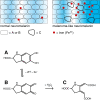Is a hypothetical melanoma-like neuromelanin the underlying factor essential for the aetiopathogenesis and clinical manifestations of multiple sclerosis?
- PMID: 23865526
- PMCID: PMC3723426
- DOI: 10.1186/1471-2377-13-91
Is a hypothetical melanoma-like neuromelanin the underlying factor essential for the aetiopathogenesis and clinical manifestations of multiple sclerosis?
Abstract
Background: Multiple sclerosis (MS) has undergone a significant increase in incidence in the industrialised nations over the last 130 years. Changing environmental factors, possibly infections or a lack of or altered timing of them, determine the prevalence of the disease. Although a plethora of aetiological factors, clearly evident in a group of children with MS, appear relevant, there may nevertheless be a single factor essential for the aetiopathogenesis and clinical manifestation of MS.
Description and discussion: This hitherto unknown factor is postulated to be a 'melanoma-like neuromelanin' (MLN) dependent on the activation of a gene for syncytin-1. An involvement of MLN could explain the diverse findings in the epidemiology, immunology and pathology of MS, requiring a consideration of a complex infectious background, the human leucocyte antigens, as well as cosmic radiation causing geomagnetic disturbances, vitamin D deficiency, smoking, and lower levels of uric acid.
Summary: In principle, the MLN-based concept is a unifying one, capable of explaining a number of characteristics of the disease. To date, MLN has not been addressed in studies on MS and future work will need to be done on human patients, as there is little or no neuromelanin (the precursor of MLN) in the animals used as experimental models in the study of MS.
Figures

References
-
- Mameli G, Astone V, Arru G, Marconi S, Lovato L, Serra C, Sotgiu S, Bonetti B, Dolei A. Brains and peripheral blood mononuclear cells of multiple sclerosis (MS) patients hyperexpress MS-associated retrovirus/HERV-W endogenous retrovirus, but not human herpesvirus 6. J Gen Virol. 2007;88:264–274. doi: 10.1099/vir.0.81890-0. - DOI - PubMed
MeSH terms
Substances
LinkOut - more resources
Full Text Sources
Other Literature Sources
Medical

